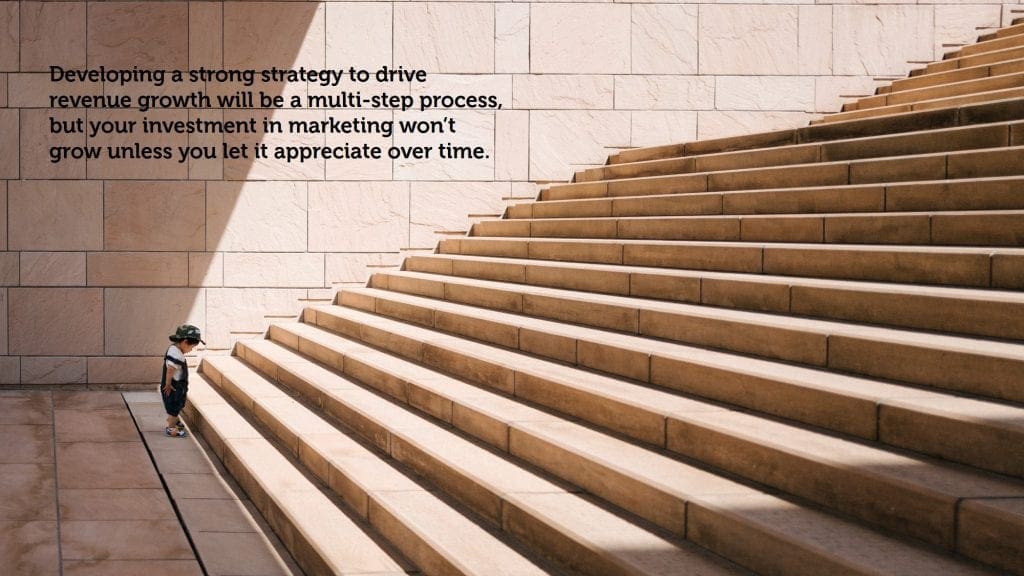How to Turn Marketing into a Profit Center
Consider these results: a five-fold revenue increase over three years, a 60% increase in ROI for TV advertising investment, saving 15% on marketing while increasing revenue by 1%. Sounds promising right? These McKinsey & Co examples are proof of the positive impact of profit center marketing.
This blog examines how to turn marketing into a profit center. As we discussed in our last blog, with profit center marketing, the marketing function generates measurable revenue for a company.
Transitioning your marketing into a profit center is not going to be painless. Success is going to require flexibility in the short-term while remaining focused on the long-term goal. These are some of the important things we’ve seen in working with clients making the move to profit center marketing.

Turning Your Marketing into a Profit Center
Many marketers are stuck in a rut of creating content and putting out messages without clear objectives. They are keeping busy, but they haven’t done the research needed to understand target audiences and their buyer’s journey. Keep these important considerations in mind when you decide to embrace profit center marketing.
Know that it’s a multi-step process.
It would be great to have a fairy godmother show up and bibbity-bobbity-boo your marketing department into a profit center. But that’s not how it works. Transitioning from the approach that has led to cost center marketing requires taking a step back to first understand the business, the service or product, the competitive landscape, the target audience, and how marketing is currently doing its job.
Developing a strong strategy to drive revenue growth and planning clear, documented processes to successfully execute the switch to a profit-driven approach will take some time. Marketing materials such as logos, websites, and content marketing assets may need revisions or rebuilding. Additionally, setting up project tracking and analytical software to track the journey can’t happen overnight either.
Impatience is a big challenge we run into working with clients shifting to a profit center marketing approach. Leadership may not yet see the value of rejigging marketing strategy — the payoff isn’t immediate, after all. Thus, they revert to ongoing demands to get “things” out there or meet arbitrary deadlines from past efforts. This can get in the way of more constructive tasks like developing the necessary strategic roadmap, rebuilding the brand, and implementing marketing automation.
A lot of things will need to happen, so manage expectations upfront. It will pay off, but you have to believe in it if you’re going to be successful. That investment is not going to grow unless you let it appreciate over time.
Get the right technology and tools.
Profit center marketing takes advantage of project management tools to ensure projects are delivered on time. Plus, with the right technologies, this revamped marketing department can better assess how marketing time and money is spent and what’s working or wasted. With digitization and clear processes backed by technology, it is easier to achieve predictable and scalable results in the long-term.
Aligning marketing with sales and business objectives means rethinking expectations. The marketing department should be focusing on more than campaign arts and design. The profit center marketer looks at metrics that matter such as number of qualified leads driven through the funnel, revenue generated, and lifetime value of a customer.
With the right tools to track touch points with customers throughout their journey, it’s easier to dial in on the activities that are driving more leads and nurturing prospects through the buying funnel. With marketing analytics tools today, marketers can quantify how many new clients, sales qualified leads, marketing qualified leads, and cold leads have been generated. They can also enjoy an extraordinary level of insight into consumer behavior and analyze campaign performance on a granular level.
Enlist support.
As with any other organizational change, the success of the shift in your marketing focus is going to require buy-in. You need to gain the support of your internal team. Involve your subject matter experts in discussions about who is responsible for what and how work will get done.
A successful profit center marketing department will be more integrated in the organization as a whole, gaining a seat at the table with decision makers. Yet, at the outset, focus on building momentum internally and building operational awareness of the changes among your marketing professionals.
This shift in strategic approach also requires financial support. There needs to be a willingness to invest in the change. At Marketri, we typically ask clients to plan on spending 5% to 7.5% of their revenue in the first year. That can be painful to hear. Especially when a realistic goal for profit center marketing is only to make that money back in the first year.
Yes, you read that correctly. Someone promising to double your ROI in the first year is probably overselling you.
After all, as mentioned already, the first year is spent developing the strategy and building out the new marketing tactics. In the second year, the marketing approach can tip over to more tactical with results that are going to pay off over time.

Get professional help.
No, we’re not talking about therapy. Still, one way to transition more smoothly is to partner with someone who has experience executing profit center marketing strategies.
Disappointed with its previous marketing agency’s efforts, one Los Angeles-based financial consulting firm tapped Marketri’s Fractional CMO services to identify target markets, clarify its brand position, and revamp its website and multi-channel marketing. With a profit-center approach, over a two-year period, the firm saw a 400% ROI.
One real estate services company also benefited with our Fractional CMO Services helping to rebrand and align its sales and marketing department. This shift in strategic marketing planning and execution led marketing to be responsible for nearly $5,000,000 of top line revenue.
At Marketri, we understand marketing and recognize every company presents a unique combination of industry, service offerings, competition, budget, audience, resources, and goals. We work with our clients to develop a strong strategy to drive revenue growth and successfully execute the switch to a profit-driven approach.
Want to learn more about building effective marketing strategies?
Want to learn more about the role that marketing plans play in growth and get insights into building good plans Then download our guide that covers 10 tips for building B2B marketing strategies:






